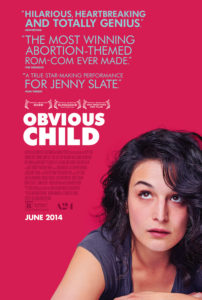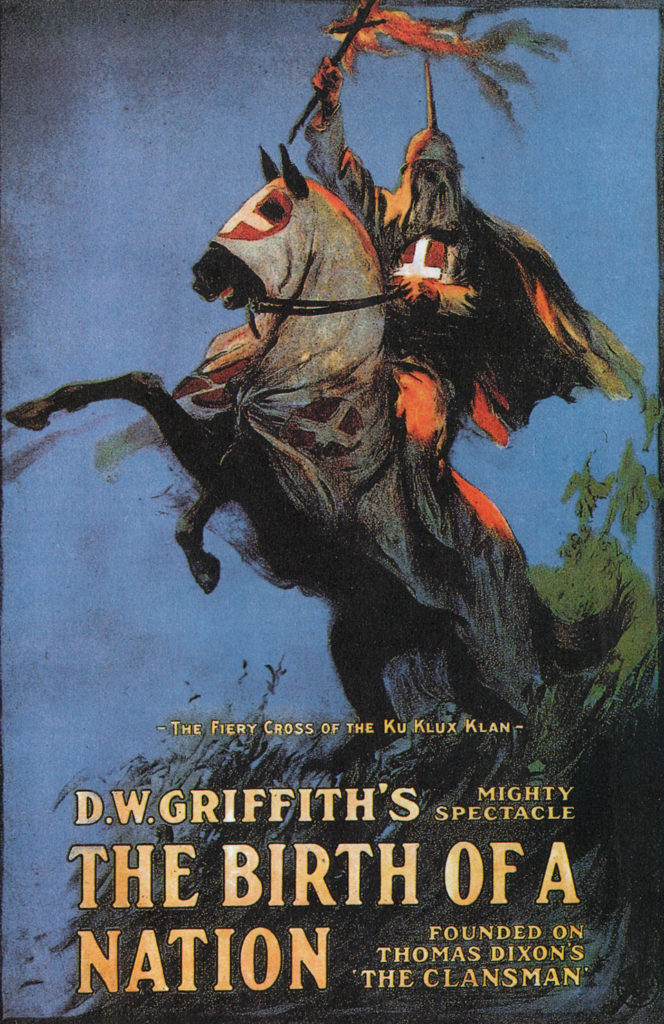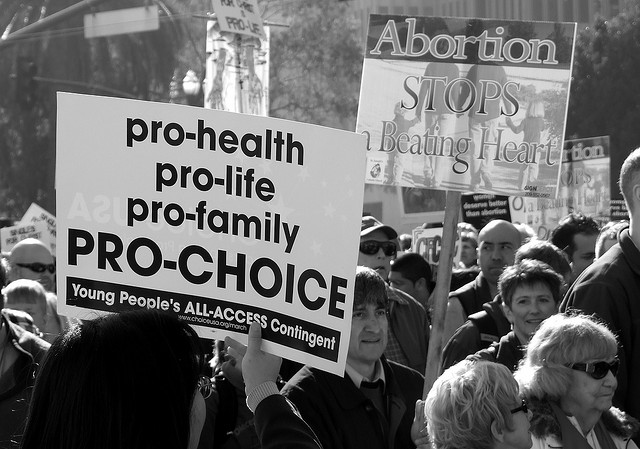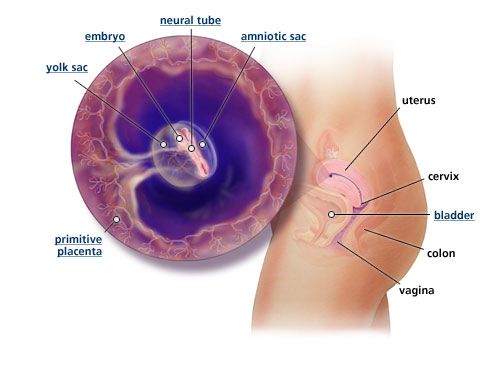THERE’S NOTHING OBVIOUS ABOUT OBVIOUS CHILD
Art, Like Life, Is Messy And Complicated And Scary And Beautiful
DIRECTOR: GILLIAN ROBESPIERRE/2014
 Let’s get the obvious out of the way first, shall we? The obvious elephant(s) in the room, as it were, standing there so very obviously in its obviousness.
Let’s get the obvious out of the way first, shall we? The obvious elephant(s) in the room, as it were, standing there so very obviously in its obviousness.
Obvious Child is a film—a romantic comedy, to be exact—in which the main character gets an abortion. Although the subject of abortion is not treated trivially or lightly, it is also not treated as controversial or a morally grey area. Rather, Obvious Child presents an unapologetically pro-choice message, asserting unequivocally that abortion is a valid expression of that choice. And although Donna Stern (Jenny Slate) is not exactly flippant about getting an abortion, it is nevertheless a decision she does not wrestle or struggle with. Writer-director Gillian Robespierre is making a clear political statement with this film—her feature debut, adapted from her 2009 short film, and clearly a labour of love.
I now approach this film as a film critic who also happens to be a pro-life Christian. On one level, these are but two separate aspects of who I am, but on the other hand, as a holistic individual, they are also intertwined with each other. I can divorce neither my faith nor my moral convictions from my art, and yet I am also called to allow them to inform one another without defining one another.
 Art criticism as a literary genre is a delicate balancing act between the subjective and the objective, the personal and the impersonal, and the experiential and the universal. Lean too far in one direction, and the criticism becomes all about the writer instead of about the art, and therefore irrelevant to anyone else. But going too far in the opposite direction is a fool’s errand of trying to quantify the unquantifiable and attempt to ascribe definitive objective value to something that is itself inherently subjective.
Art criticism as a literary genre is a delicate balancing act between the subjective and the objective, the personal and the impersonal, and the experiential and the universal. Lean too far in one direction, and the criticism becomes all about the writer instead of about the art, and therefore irrelevant to anyone else. But going too far in the opposite direction is a fool’s errand of trying to quantify the unquantifiable and attempt to ascribe definitive objective value to something that is itself inherently subjective.
Art may be a matter of opinion, but at the same time, opinion matters. Not all perspectives are equally valid; the more studied and thought-out an opinion is, the greater weight it carries. And so while we should be very careful about saying that there can be any such thing as a valueless expression of art, those of us who study art can nevertheless attempt to describe exactly how much value it merits—i.e., whether or not the expression could be called “good” art or “bad” art.[1]
For critics with clear moral, social, religious, and/or political convictions, the tightrope can become even more perilous, as we wrestle with judging art that presents a clear message which fundamentally conflicts with our core beliefs. It’s easy when the art is clearly bad (see my Need For Speed review), but what about when the art is really well-made?
 Perhaps one of the most famous examples of this dilemma is the landmark silent film Birth of a Nation (Dir. D.W. Griffith, 1915), a film that even for its time was unapologetically ugly in its blatant and poisonous racism; a hagiography of the Ku Klux Klan, featuring the demonization of African-Americans portrayed as bloodthirsty, sub-human savages, by white actors in blackface, no less! Yet at the same time, the film is a masterwork of technical proficiency and artistic achievement, almost singlehandedly taking the art form into the future through a number of filmmaking innovations that still reverberate in cinema today. Some film scholars would even call it the most important film in American history, despite its vile and hideous message.
Perhaps one of the most famous examples of this dilemma is the landmark silent film Birth of a Nation (Dir. D.W. Griffith, 1915), a film that even for its time was unapologetically ugly in its blatant and poisonous racism; a hagiography of the Ku Klux Klan, featuring the demonization of African-Americans portrayed as bloodthirsty, sub-human savages, by white actors in blackface, no less! Yet at the same time, the film is a masterwork of technical proficiency and artistic achievement, almost singlehandedly taking the art form into the future through a number of filmmaking innovations that still reverberate in cinema today. Some film scholars would even call it the most important film in American history, despite its vile and hideous message.
This is the artistic rub, as it were. Good, even great, art does not always mean a good or great message, and the two can often be in direct conflict. This is because artistic value comes from a whole host of factors, from the execution, to the inherent verisimilitude, to the quality of the artistic expression itself, and so on and so forth. Or, to put it in theological terms, we must not only examine the logos (message) of the art, but the pathos (emotional/relational credibility) and the ethos (honesty, trustworthiness, or even the “truthiness”) of the art as well.
This can be an artistic pitfall for many in the Church—not only in criticism, but in creation as well. Although this presumption is slowly changing, there has long been a baseline assumption when it comes to “Christian” art, which prescribes the primacy of the logos above all other concerns. In other words, the capital-M Message is placed in a disproportionate position of primacy over all other artistic concerns. Poetry, beauty, reality, and even truth can all be sacrificed on the altar of the Clear Moral Message. And if the Five Spiritual Laws can be worked into it as well, then so much the better.
As the Bride of Christ crosses the threshold of the 21st century, this perspective is slowly changing. Righting a ship as large as the Church—especially when that ship has fragmented into a million different lifeboats, most of which are traveling along different oceanic currents—is a massive endeavor that takes a lot of time, a lot of grace, and a lot of patience. But I believe that just as He sanctifies His children, God is sanctifying His Church as well, and that includes bringing back a Biblical perspective on art that much of the Church has lost over the centuries.[2]
ZekeFilm aims to be part of that conversation and part of that change, albeit in our own small, insignificant way. We seek to judge art based not on only on its message but on its artistic value, while doing so from a Biblical perspective. And so when a movie like Obvious Child comes along, it really forces us to put our money where our mouths are, so to speak. In other words, platitudes about artistic value are all fine and good, but will we have the courage of our convictions when it comes down to the wire, and we’re presented with a film like Obvious Child, which presents us with a challenge to that assertion?
More than any other hot-button issue, abortion has been the single biggest galvanizing concern for the Western Church in the late-twentieth and early-twenty-first centuries. Roe v. Wade was a watershed moment in the modern history of the Western Church—a moment that united American Christendom in way that the Church has seldom been united since the sixteenth century. It was the legalization and legitimization of abortion as a social reality that presented the single biggest political shift in the American Evangelical Church, in which a body that had been comparatively politically diverse beforehand suddenly shifted deep into the red. Even now, most Christians would identify as pro-life—even many of those who self-identify as liberal and/or progressive. Believers who proudly call themselves feminist, LGBTQ-friendly, and even card-carrying democrats will often hesitate to call themselves “pro-choice,” and if they do so, it is usually with plenty of qualifiers, and only disclosed to trusted friends and/or progressive allies.

All of this is with good reason. After all, we’re talking about human life here—no matter where you believe the line is drawn (conception, implantation, quickening, birth, or anything in between), we are talking about the life of a human being, either in actuality or in potential. Without any sense of hyperbole, it can be accurately stated that the abortion debate is literally a life-or-death issue.
And yet it is seldom as black-or-white as those with their feet firmly planted on either side of the debate would have you believe. Despite the prevalence and plurality of strong opinion, it can be difficult to definitively delineate the exact moment at which point a life becomes “viable,” “human,” or however you wish to define it. For some on the most liberal side of the pro-choice position, that line is clearly drawn at birth and at no time beforehand. For some on the most conservative side of the pro-life position, that line may be drawn even before conception (as much of the Church—notably the Roman Catholic Church, which remains the single-largest church body—forbids the use of birth control). Some Christians believe in the pre-existence of souls. Other Christians believe in the pre-destination of individuals for salvation or destruction. Some Christians believe in an “age of accountability,” at which an individual becomes capable of understanding (and either accepting or rejecting) the Gospel of Jesus Christ, and anyone who dies before this age goes straight to Heaven regardless of their belief or the belief of their parents. Other Christians believe this only applies to “covenant children,” or children of parents who already believe in Jesus Christ.
All of these disparate and/or complementary theologies impact one’s belief about abortion. Yet coming to an irrefutably objective conclusion continues to elude us, from both a theological and a scientific perspective. The Bible is curiously mum when it comes to specifics on the subject, despite the fact that abortion existed when the Scriptures were being written. This can (and has) been interpreted many different ways by theologians and Christians on both sides of the abortion debate. As for scientific discovery—while we can certainly pinpoint the existence of “life,” we cannot prove the existence of the soul. And if it is the soul that makes us truly human, how then can we scientifically demonstrate the point at which the soul enters (or spontaneously erupts into being) the human body? And how does belief or disbelief in the soul impact public policy in a secular nation?

Fetal development at five weeks, the point in the film at which Donna Stern (Jenny Slate) has an abortion. At this stage, the heartbeat has developed but neurons have yet to generate; that happens at six weeks. Is this a viable human being or not?
Further compounding the issue is all of the tangential issues that might not be directly related to the question of abortion but have become a seemingly permanent part of the discussion, inseparable from the issue at hand: birth control, autonomy over one’s own body, feminism, the separation of church and state, etc. etc. Add this to the fact that the pro-life movement has become so fundamentally associated with many other conservative positions—several of which are counter-intuitive and counter-productive to actually reducing the number of abortions (abstinence-only sex education, a rejection of universal and/or socialized health care, and economic austerity at the expense of social welfare, to name a few)—and the debate becomes even more muddled. All of this to say that at the end of the day, the answer to the abortion question is not as obvious as one might assume.

Writer-director Gillian Robespierre and star Jenny Slate
And yet for writer-director Gillian Robespierre, the answer is obvious. Donna’s choice is neither difficult nor agonizing—the drama in the film comes from how she well tell the father (Jake Lacy), not from the decision to abort, which is taken as a given. Yet while this aspect of the film may be fairly obvious, I daresay the way we get there is anything but. Here’s the sticky widget: from an artistic standpoint, Obvious Child is actually really good. It’s very well-written, with heightened screwball dialogue that is memorable yet flows naturally. It’s even better acted, with Jenny Slate giving one of the best performances of the year; she’s funny and acerbic and hopeless and sympathetic and vulnerable and compelling—oftentimes all at the same time. It’s the same kind of multi-layered performance I lauded Emily Blunt for in Edge of Tomorrow—the kind of acting that few actors are able to achieve, yet Slate is demonstrating at the relatively young age of 32. It’s well-directed—especially for a feature debut, with a great sense of pacing and character development. Robespierre wisely gives us plenty of time to get to know and love her heroine, so that when she makes the decision to abort, somewhere around the mid-point of the film, we’re already completely sympathetic with her as a character, having gotten to know her fully as a flawed, struggling human being—we see her heart broken, we see her fighting and scrapping through life, and we see her grasping at straws of happiness. She is not a statistic, or a theoretical abstract—she is a living, breathing character who is making a significant life decision. Even if we do not agree with her—even if we think that abortion is murder—Robespierre is too good a filmmaker and Slate is too good of an actress for us to not be able to relate to Donna’s situation and see it with a sympathetic viewpoint.
I’m a Christian, and I’m pro-life. That’s part of who I am, and I can’t separate that part of myself from the artist, the critic, the father, or the thousand other things that I am. Life and art and people and politics are holistic and messy and complicated and anything but obvious. And yet a story well-told; a film well-made; a piece of art that demonstrates care and talent and ability—the inherent value of such a thing is obvious (or at least it should be). A great movie doesn’t stop being a great movie because it’s pro-choice.
I believe that all good art is true on some level, and that all truth is God’s truth. I don’t believe it’s true that abortion is always a valid choice or that it’s ever without moral complications. I believe this is a Biblical viewpoint. But Obvious Child has plenty of things that do ring true—the fear and perils of young adulthood; the messy and difficult process of getting to know someone and falling in love; the pathos of dealing with pain through one’s art. Its position on abortion is wrong, but it’s right to address the topic. I don’t know if Obvious Child will do anything for the national conversation about abortion any more than Lars Von Trier’s Nymph()maniac will encourage us as a culture to be more open about discussing our sexuality, but at least Gillian Robespierre is talking about it instead of loudly screaming about it (she even lampoons the archetypal loud, angry, and militant liberal a bit in one particular scene). Perhaps we can do the same?
[1] A crucial distinction—classifying art as “good” or “bad” is in no way the same thing as ascribing an artificial and/or arbitrary distinction between “high” art and “low” art. Much art considered “high” can be bad, and much art considered “low” can be quite good. “High art” and “low art” are artificial constructs with their roots in classism and economic prejudices.
[2] Especially post-Protestant Reformation, after which a new breed of utilitarian asceticism began to creep back into the Protestant Church, when much of the beautiful art of the Roman Catholic Church was dismissed as idolatrous.

